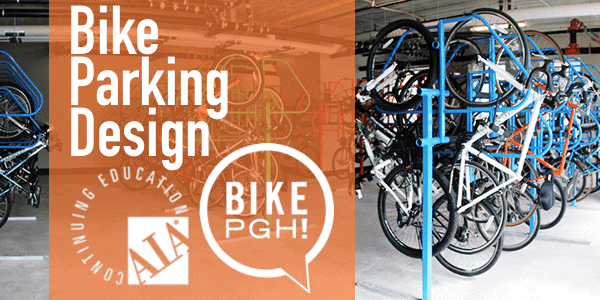September 4th lunch+learn to explore typology, design, and zoning for bike parking
Bike Parking Design: Building Active + Engaged + Healthy Communities
American Institute of Architects offering 1.5 LU/HSW Credit Hours to Registered Architects
Speakers
Dan Yablonsky, BikePGH
Eric Osth, Urban Design Associates
Jonathan Kline, Studio for Spacial Practice
Kristin Saunders, City of Pittsburgh
Lena Andrews, Action Housing
Course Description
The times are a-changing, and they’re doing so without the car. For the first time in two generations, the Millennials fueling our country’s urban population growth are driving less and relying more on biking, walking, and transit. Since Y2K, our country saw a 61.8% increase in the number of people biking to work (Pittsburgh can tap itself on the back – as we saw the country’s largest increase, at 408%). Across the board these numbers are continuing to grow as Federal, State, and Local governments build infrastructure and pass legislation that promotes bicycling for transportation and recreation. The bottom line is that populations are benefiting. Studies show that biking builds communities that are healthier, happier, more productive, and more environmentally sustainable than ever.
Obviously, more people riding bikes means more people parking bikes too, and admittedly, bike parking is not as sexy as bike riding. However, there is a real pressure building for quality start/end of trip facilities. Architects, developers, building managers and City Zoning Codes are rising to the challenge and reaping the economic, environmental, and public health benefits. This workshop will explore how they’re building healthier, more connected communities by creating bike parking facilities that are secure, accessible, space efficient, cost saving, and might we even say, sexy.
Learning Objectives
1. Understand the many benefits that biking and pro-bike infrastructure + policy lend to the creation of dense, healthy and environmentally sustainable urban environments.
2. Discuss how to integrate various types of biking parking into both the urban environment and architectural projects, and see examples of these strategies in local projects.
3. Explain how architects are utilizing Pittsburgh’s and other city zoning codes to build creative bike parking facilities that save client costs and increase community health and wellness.
4. Identify a number of preferred bike racks and brainstorm with colleagues on how they’re incorporating them into designs.
 Subscribe to BikePGH’s Quarterly Business Newsletter
Subscribe to BikePGH’s Quarterly Business Newsletter
We want to keep our business contacts up to date with this new Quarterly Business Newsletter. Stay tuned to catch all the developments, programs and opportunities for involvement in the months to come.
